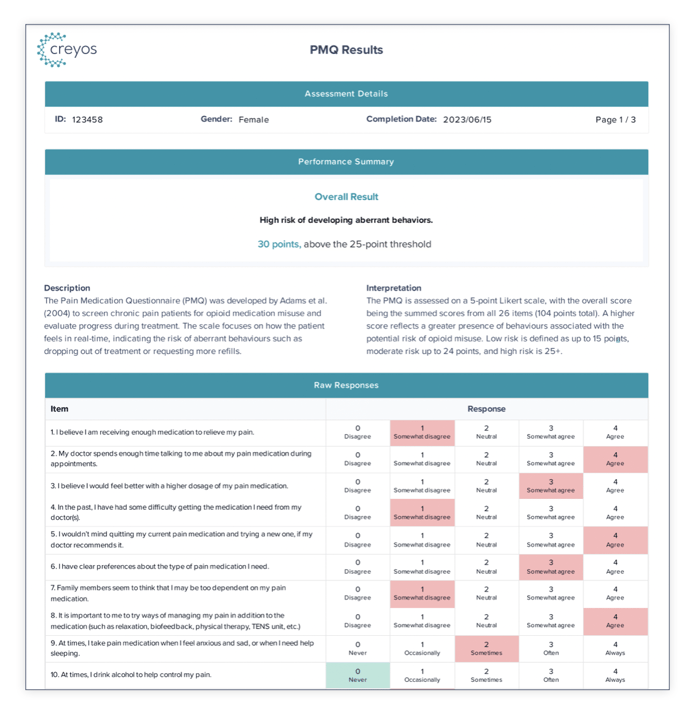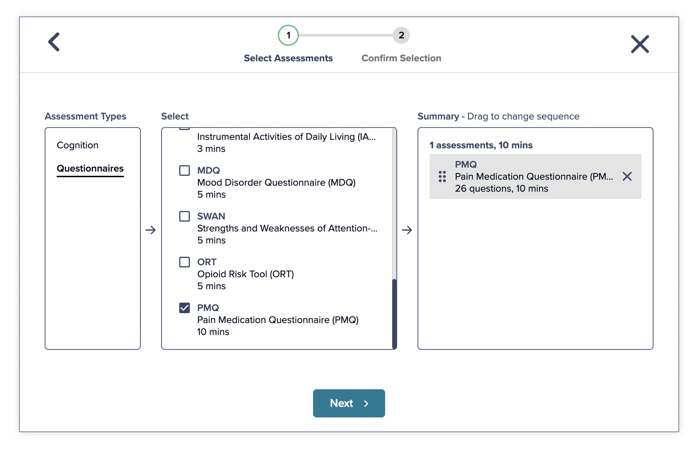
Measure Pain Medication Misuse Risk With the Pain Medication Questionnaire (PMQ)
Published: 26/07/2023
Written by: Creyos
16 million Americans over the age of 12 abuse prescription drugs each year, according to the National Center for Drug Abuse Statistics, with 52 million Americans having misused this type of drug at least once in their lives. For this reason, it is extremely valuable for clinicians prescribing pain medication to have a way of screening patients for behaviors associated with a risk of substance abuse.
The Pain Medication Questionnaire (PMQ), now offered within Creyos Health, is a tool that assists with quickly and efficiently assessing the risk level of potential opioid medication misuse in patients between the ages of 17 and 84.
What is the Pain Medication Questionnaire (PMQ)?
The Pain Medication Questionnaire was developed in 2004 by Adams et al. in order to easily identify patients who need a more thorough assessment for risk of opioid medication misuse or substance abuse. It's intended to aid clinicians in determining which patients might be suitable for opioid treatment to alleviate conditions like chronic pain (Holmes et al., 2006). Unlike other questionnaires concerning the use of pain medication, the PMQ is not for pre-treatment use, but instead is intended to be an opioid screening instrument to measure the risk of patients who are already taking opioids in order to help clinicians spot potential opioid misuse and intervene for better treatment outcomes. (Passik and Kirsh, 2006).
Though the 26 questions that make up the PMQ were developed using literature pertaining to opioids, the PMQ is intentionally non-specific in terms of what type of medication it is referring to, and can therefore be applied to any form of pain medication or substance abuse (Adams et al., 2004).

How does the Pain Medication Questionnaire work?
Each item on the questionnaire aims to assess how a patient feels about their pain or current medication at the time of assessment, and is answered on a 5-point scale, normally ranging from “disagree” to “agree” or “never” to “always.” Each response on the scale is associated with a different number of points, and the total sum of a patient's points at the end of the questionnaire indicates their risk level. The point cutoffs for each risk category are 0-15 points for low risk, 16-24 points for moderate risk, and 25-104 points for high risk.

A long-term study conducted in 2006, which involved several of the original developers of the PMQ, found that participants whose questionnaire scores fell within the highest one-third were 2.6 times more likely to have a substance abuse issue, as well as 2.3 times more likely to drop out of treatment and 3.2 times more likely to seek refills prematurely compared to those whose scores put them in the lowest one-third (Holmes et al., 2006).
How is pain medication use for pain management related to cognition?
Substance abuse and cognition are deeply interconnected, with one recent study describing the relationship between the two as bidirectional—not only can substance abuse lead to cognitive deficits, but pre-existing cognitive impairment is also a risk factor for future substance abuse (Melugin et al., 2021).
The impacts of opioids and opioid therapy on cognition are undoubtedly deserving of attention as, according to the Centers for Disease Control and Prevention, 6.5% of adults over the age of 20 will report having very recently used prescription opioids. Opioids can have an impact on short-term cognition (Cherrier et al., 2009) and, when used chronically, may also have long lasting effects on a variety of cognitive domains (Warner et al., 2022).
The cognitive implications of opioid use may not end with the impacts of prescribed use, as use can often turn into misuse. Researchers have found that those seeking treatment for opioid abuse score lower on tests of visuospatial ability compared to those in recovery from other types of substance use disorder (Bruijnen et al., 2019). Attention, episodic memory, and working memory have also been shown to be impaired (Kamboj et al., 2005; Sjøgren et al., 2004).
Chronic pain itself also plays a role in cognition. One study (McCracken & Iverson, 2001) reported cognitive deficits in 54% of chronic pain patients, particularly in domains such as episodic memory and attention, suggesting the need for routine assessment. Mental health conditions appeared to play a large role in deficits, with severe chronic pain contributing to patient well-being—depression can be measured in Creyos Health using the PHQ-9.
Creyos Health’s neuropsychological tasks can help clinicians working with chronic pain patients and pain medications for pain management monitor these effects on cognition over the course of treatment, alongside the PMQ and additional questionnaires like the AUDIT, the DAST-10, and the ORT, which are all available within the Creyos Health platform.
How to administer a computerized version of the Pain Medication Questionnaire in Creyos Health
Like all questionnaires within Creyos Health, the PMQ can be completed quickly and easily, on its own or within a protocol alongside other questionnaires and Creyos cognitive tasks.
To include the PMQ in a Creyos Health assessment, simply click on the Questionnaires tab under Assessment Types when creating a protocol and then select the PMQ. Select any other questionnaires or cognitive assessments in addition to the PMQ in order to combine them all into one seamless patient experience.

For detailed instructions on administering questionnaires within Creyos Health, please see our previous blog post on administering a computerized version of the PHQ-9.
Thanks to its digital nature, the Creyos Health version of the PMQ can be taken either at home or in-clinic, and it requires no special training to administer. The PMQ can also be added to a Creyos Health schedule, allowing you to regularly send it automatically via email. The results are scored instantly and added to an easy-to-interpret PDF. No patient login or registration of any kind are required in order to complete the questionnaire, so with minimal effort, clinicians and patients can benefit from this standardized screening method for potential pain medication misuse.
Need more digital health questionnaires for pain management, drug concerns or better treatment plans for chronic pain patients?
If there are any questionnaires that you are using today as part of your practice that you would like to see become available in a computerized format within Creyos Health, please do not hesitate to let us know by contacting us through email at help@creyos.com or commenting on this blog post.
